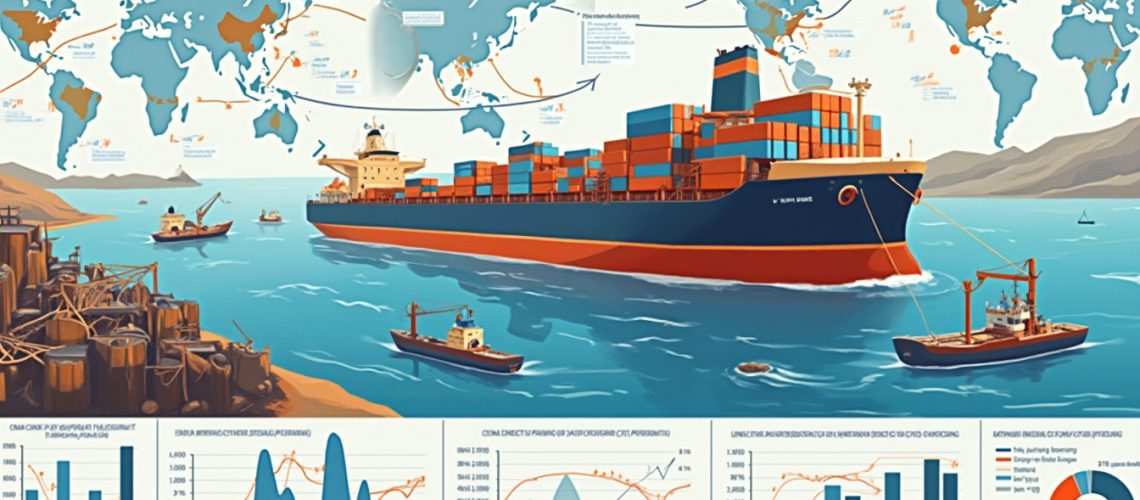China's 2024 Iron Ore Imports: A Comprehensive Market Analysis
The Chinese iron ore import market in 2024 witnessed unprecedented developments that not only impacted the domestic steel industry but also had far-reaching effects on the global commodities market. Amidst a backdrop of fluctuating prices, policy shifts, and evolving trade relationships, China solidified its position as a dominant force in iron ore consumption. This comprehensive analysis delves into the factors driving this remarkable trajectory, exploring how robust purchasing strategies and complex market dynamics have shaped the landscape. Understanding these nuanced trends provides critical insights into the world's largest steel production ecosystem and anticipates future market movements.
Record-Breaking Import Performance
China's iron ore imports soared to an unprecedented 1.24 billion metric tons in 2024, marking a 4.9% increase from the previous year's 1.18 billion tons. This significant uptick underscores the resilience and voracity of China's steel manufacturing sector, even as it grapples with ongoing challenges in the property market and broader economic uncertainties. The record import levels were driven by a combination of factors, including aggressive purchasing strategies by steel mills and traders capitalising on lower global iron ore prices.
The surge in imports also reflects China's strategic approach to securing essential raw materials for its vast industrial base. By stockpiling iron ore during periods of price decline, China not only ensures a steady supply for its steel production but also exerts considerable influence on global commodity prices. This approach has significant implications for international iron ore suppliers and for countries heavily reliant on iron ore exports.
Market Dynamics Driving Imports
Several key factors contributed to China's remarkable iron ore import performance in 2024:
- Lower Iron Ore Prices Stimulated Aggressive Purchasing: The average imported iron ore price declined by 31%, creating an attractive environment for bulk purchasing. This price reduction was largely due to fluctuations in global demand and supply dynamics, as well as geopolitical tensions affecting international trade routes.
- Robust Demand from Blast Furnace Steelmakers: Chinese blast furnace steelmakers maintained strong demand for iron ore, capitalising on lower costs to sustain and even increase production levels.
- Strategic Stockpiling by Traders: Traders engaged in strategic stockpiling at favourable price points, anticipating future price increases or supply constraints. This led to portside stocks increasing by 28% to 146.85 million tons.
Moreover, China's economic stimulus played a crucial role in shaping market dynamics. The government's efforts to stabilise the economy and support industrial growth bolstered confidence among steel producers. Despite challenges in the property market, the infrastructure and manufacturing sectors continued to drive steel demand. This complex interplay of factors underscores the sophisticated strategies employed by market participants to navigate the ever-changing landscape.
Steel Production Landscape
China's steel production in 2024 exhibited a nuanced performance, reflecting the complexities of the industry's operational dynamics:
- Overall Steel Output Declined: Overall steel output declined by 2.7% in the first 11 months, influenced by environmental regulations, market saturation, and reduced demand from the property sector.
- Weak Production from Electric Furnace Steelmakers: Electric furnace steelmakers experienced particularly weak production due to higher operational costs, fluctuating scrap steel prices, and environmental policies aimed at reducing carbon emissions.
- Consistent Output from Blast Furnace Producers: Blast furnace steel producers maintained consistent, and in some cases, increased output. These traditional steelmakers benefited from lower iron ore prices and economies of scale. Their adaptability and cost-effectiveness allowed them to sustain operations despite broader industry challenges.
Furthermore, the sustained demand for steel in infrastructure projects and manufacturing sectors provided a buffer against declines in other areas. While the property market faced downturns, government-led initiatives in infrastructure development continued to require substantial steel inputs. This demand supported blast furnace production and underpinned the overall stability of China's steel supply chain.
Strategic Stockpiling and Price Dynamics
In 2024, traders and steelmakers in China demonstrated sophisticated market strategies by leveraging lower iron ore prices to optimise their supply chains. The December import volume alone reached 112.49 million tons, reflecting a calculated approach to inventory management and anticipation of future market conditions. This substantial monthly import volume was one of the highest on record, indicating a concerted effort to capitalise on favourable pricing.
The strategic stockpiling was driven by expectations of price rebounds due to potential supply disruptions and increasing demand from infrastructure projects. By securing large quantities of iron ore at lower prices, Chinese traders and steel producers positioned themselves advantageously against competitors. This approach not only stabilised their raw material costs but also allowed them to exert influence over market prices through controlled release of stockpiled resources.
Moreover, the stockpiling activities had significant implications for global iron ore markets. Increased Chinese imports tightened supply availability for other countries, contributing to upward pressure on global prices. This dynamic showcases China's substantial impact on worldwide commodity markets and highlights the intricate balance between domestic strategies and international trade relations.
Global Trade Implications
China's record-breaking iron ore imports and steel production had significant repercussions on global trade dynamics in 2024. Notably, China's steel export performance reached a nine-year high of 110.72 million tons, representing a 22.7% increase compared to 2023. This escalation in exports was driven by competitive pricing and abundant supply facilitated by strategic stockpiling and efficient production methods.
However, the surge in Chinese steel exports triggered trade tensions with multiple countries concerned about the impact on their domestic industries. Notable responses include:
- Turkey: Implemented anti-dumping duties on Chinese steel products to protect its domestic steel industry from the influx of cheaper Chinese steel that could undercut local producers.
- Indonesia: Introduced protective trade measures, including tariffs and import restrictions on Chinese steel, aiming to support its growing domestic steel industry and reduce dependency on imports.
The heightened imports by China boosted Australian iron ore miners, despite geopolitical strains and discussions about diversifying trade partnerships. Australia's economy, in particular, is closely tied to iron ore exports to China, and the increased demand provided a significant economic stimulus.
These actions reflect escalating global trade tensions and a shift towards protectionism. Countries are increasingly vigilant about safeguarding their industries against competitive pressures from nations like China, whose production capabilities and pricing strategies can significantly alter market dynamics.
Future Market Outlook
Projections for 2025 suggest that China's iron ore imports could potentially reach new record levels:
- Continued Impact of Property Sector Challenges: The ongoing downturn in real estate may paradoxically drive strategic stockpiling, as traders and steelmakers anticipate future demand from infrastructure and manufacturing sectors.
- Ongoing Strategic Purchasing by Traders: Traders are likely to continue leveraging price fluctuations to optimise their supply chains and maintain a competitive edge.
- Potential for Further Market Volatility: Geopolitical tensions, trade disputes, and global economic uncertainties could contribute to market volatility, affecting both supply and pricing.
For a more detailed analysis of the market trends and strategic insights shaping China's iron ore imports in 2025, industry professionals can refer to specialised reports. The persistent property sector downturn might paradoxically drive strategic stockpiling, as traders and steelmakers seek to optimise their supply chains.
Investment and Market Insights
Key takeaways for investors and industry observers include:
- Price Volatility Creates Opportunities: The price volatility inherent in the market creates chances for strategic purchasing and profit maximisation. Understanding the timing of price fluctuations and the underlying factors can enable investors to make informed decisions.
- Adaptability of Blast Furnace Steelmakers: Blast furnace steelmakers demonstrate remarkable adaptability and resilience. Their ability to maintain consistent output amidst market pressures highlights potential investment opportunities.
- Global Trade Tensions Might Reshape Future Dynamics: Global trade tensions and protective measures by other countries could reshape future import-export dynamics. It's crucial for investors to monitor geopolitical developments and assess how changes in international relations might affect China's steel exports and raw material imports.
Staying informed about policy shifts, environmental regulations, and technological advancements in steel production can also provide valuable insights. The transition towards more sustainable and environmentally friendly production methods may influence future market trends and investment priorities.
Frequently Asked Questions
Why are China's iron ore imports increasing despite the property crisis?
China's iron ore imports are increasing despite the property crisis due to several key factors:
- Cost-Competitive Blast Furnace Steelmakers: Traditional blast furnace steelmakers continue to operate efficiently, benefiting from lower iron ore prices. Their cost-effective production methods enable them to maintain output levels and meet demand from sectors outside of property development, such as infrastructure and manufacturing.
- Strategic Stockpiling at Lower Prices: Traders and steel producers engage in strategic stockpiling of iron ore when prices are favourable. This approach allows them to secure raw materials at lower costs, hedge against future price increases, and ensure a steady supply for ongoing production needs.
- Strong Export-Driven Steel Production: China's steel industry is not solely dependent on domestic property construction. The significant increase in steel exports, reaching a nine-year high, demonstrates that international demand is driving production. Chinese steel remains competitive in global markets due to its pricing and availability, stimulating continued iron ore imports to support these export activities.
Additionally, the government's economic stimulus targeting industrial growth contributes to sustained demand for steel and, by extension, iron ore imports. The diversification of steel demand across various sectors mitigates the impact of the property crisis on overall imports.
What countries have responded to China's steel exports?
Several countries have taken measures in response to the surge in China's steel exports due to concerns over market saturation and the impact on their domestic industries. Notable responses include:
- Turkey: Implemented anti-dumping duties on Chinese steel products to protect its domestic steel industry from the influx of cheaper Chinese steel that could undercut local producers.
- Indonesia: Introduced protective trade measures, including tariffs and import restrictions on Chinese steel. Indonesia aims to support its growing domestic steel industry and reduce dependency on imports.
- European Union: Has historically investigated Chinese steel imports and imposed anti-dumping duties to prevent market distortion and ensure fair competition within its member states.
These actions reflect escalating global trade tensions and a shift towards protectionism. Countries are increasingly vigilant about safeguarding their industries against competitive pressures from nations like China, whose production capabilities and pricing strategies can significantly alter market dynamics.
The 2024 iron ore import landscape reflects a complex interplay of economic, strategic, and geopolitical factors, positioning China at the centre of global steel production dynamics. As the country continues to navigate these challenges, its actions will undoubtedly influence international markets and trade relationships in the years to come.
Want to Stay Ahead in the Iron Ore and Steel Investment Landscape?
Discover valuable opportunities with Discovery Alert's real-time notifications on significant ASX mineral discoveries, which provide crucial insights into iron ore and steel-related investments. Our AI-powered alerts simplify complex market data, helping investors—from newcomers to seasoned traders—capitalize on short-term trades and long-term potential in the rapidly evolving resources sector.







